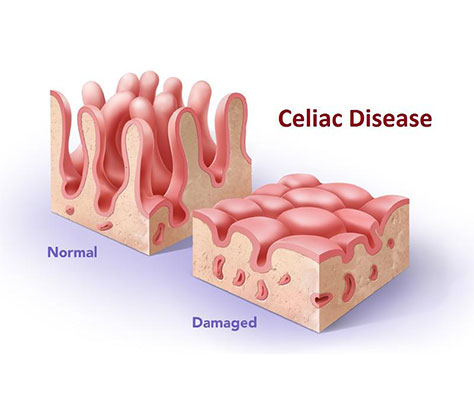What is Celiac Disease (CD)?
Celiac disease (CD) is a chronic (long-term) digestive disease during which patients have irritation (inflammation) of the small intestine, which causes difficulty with absorbing nutrients from food. Patients with CD often have other family members with the condition and are therefore susceptible to this disease. Inflammation in the intestine occurs when a patient with CD begins to eat food that contains gluten. Gluten is the name given to certain types of proteins found in wheat, barley, rye and related grains. Oats are currently considered not to be dangerous to persons with CD. However, due to the high possibility of contamination with other gluten containing grains, oats are typically not recommended for people with celiac disease.
When food containing gluten arrives in the small intestine, the immune system reacts against the gluten, causing an inflammatory reaction in the wall of the intestine. The small intestine lining is covered by millions of villi (see figures 1–3), finger-like projections that act to increase the surface area of the intestine allowing increased absorption of nutrients. The villi are damaged by the inflammation in CD, which results in a decrease in the absorption of food. When gluten is removed from the diet, inflammation is reduced and the intestine begins to heal. The time when a patient develops symptoms varies from patient to patient after their first contact with the gluten protein. In many cases, it may be decades before symptoms and signs develop, often precipitated by a trigger.
How common is Celiac Disease?
In the U.S., approximately 1 out of every 100 people may have CD, though only 1 out of 5 people with celiac disease may be actually diagnosed and are aware that they have this disease. Some of these patients have mild forms of the disease and may have no symptoms or only mild symptoms. There may be as many as 2–3 million people in the United States and 20 million in the world with CD.
CD affects many ethnicities, with the highest prevalence in Caucasians. Infants and children may have celiac disease, but CD is more commonly diagnosed in adulthood, and people can be diagnosed even in their seventies or eighties. Female patients are more likely to be diagnosed with celiac disease than male patients. Individuals that have type 1 diabetes, thyroid disorders, or relatives with CD are at greater risk for developing CD.
